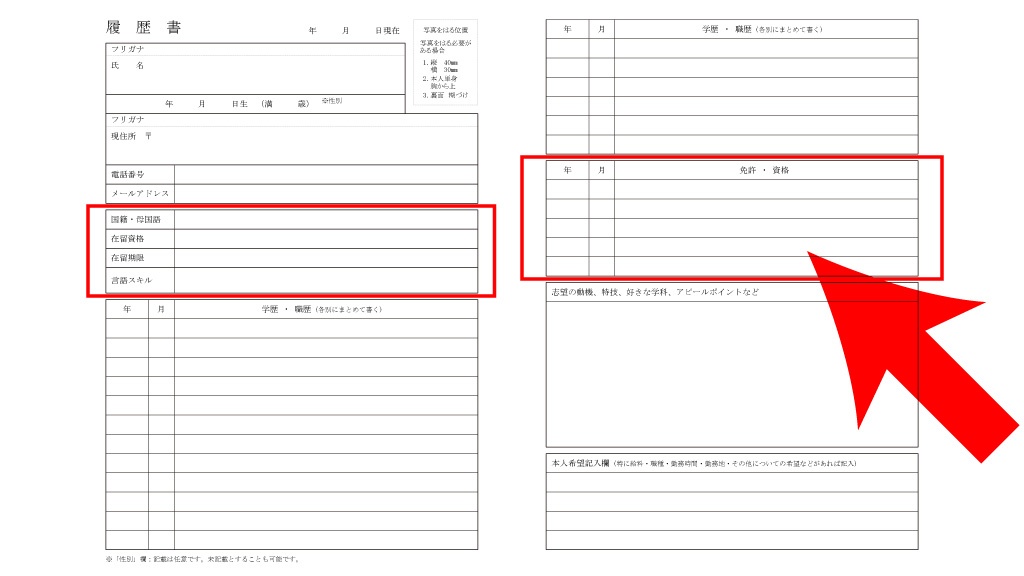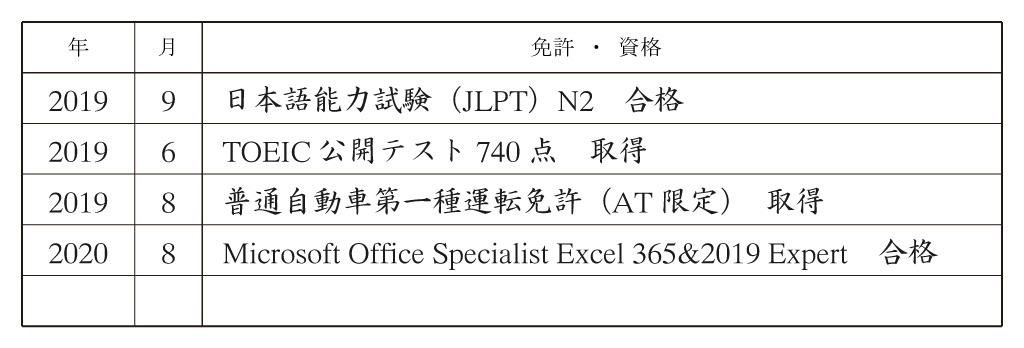How to Describe “License/Qualifications” in your RIREKISHO – Documents required for job hunting 07

This post is also available in 日本語
In the “RIREKISHO” required when looking for a job in Japan, there is a space for writing licenses and qualifications. This is a column for you to appeal to the particular knowledge and skills you have obtained, so please enter this carefully. On this occasion, I would like to introduce you in detail to how to describe “Licenses/qualifications”.
Further, in the RIREKISHO that can be downloaded from “Living in Japan”, there are original items for which there are no corresponding entry columns in common RIREKISHO. We shall also explain about these items.
Related Articles on Documents Required for Job Hunting
- 01 What is a RIREKISHO and SHOKUMU KEIREKISHO?
- 02 Size of the RIREKISHO and SHOKUMU KEIREKISHO
- 03 Format types and Downloading templates(PDF/Word/Excel)
- 04 How to Write “Basic Information” in the RIREKISHO
- 05 “Photograph” to affix to the “RIREKISHO”
- 06 How to Describe “Academic History/Work History” in your RIREKISHO
- 07 How to Describe “License/Qualifications” in your RIREKISHO
- 08 How to Describe “Reason for Application” in your RIREKISHO
- 09 How to Describe “Personal Requests” in your RIREKISHO
Contents
Differences Between Licenses and Qualifications
When you obtain a license, you are permitted to perform actions that are normally restricted or prohibited. Qualifications, on the other hand, indicate that your knowledge or skill has reached a certain level.
It may be easy to remember the difference in terms of whether “people without it would be punished if performing that action”. For example, if somebody without a driver’s license drives a car, they would be punished. However, if somebody without a secretarial qualification performs a secretary job, they would not face punishment.
How to Describe “License/Qualifications”

In the first column, enter the “Year”, then the “Month”, and finally the “Content” in the final column. You can use either the Western or Japanese calendar system. Be sure to standardize the notation with other items and SHOKUMU KEIREKISHO.
What kind of licenses and qualifications should you enter
Prioritize entry of licenses and qualifications useful in your desired profession. If a high level of language skills is required, prioritize information related to languages. Do not describe qualifications unrelated to your chosen profession.
However, an ordinary vehicle driver’s license is an exception to this. Even if your desired profession seems unrelated, there is a possibility that it may suddenly become necessary in future. If you have an ordinary vehicle driver’s license, make sure you include this. Recently, the ability to use a PC is sought in all workplaces, so include any PC-related qualifications you have obtained, such as MOS.
If you have obtained multiple levels of the Japanese Language Proficiency Test (JLPT), such as N3 and N2, enter only the highest level of the test that you have passed.
Order of Entry
There are no particular rules about the order of entering licenses and qualifications. However, it may be good to enter them in the following order to appropriately appeal to required knowledge and technical abilities.
- Any licenses or qualifications described in the application requirements in the recruitment information
- Information related to language skills
- Ordinary vehicle driver’s license
- Licenses and qualifications related to the work or profession applied for
- PC-related qualifications, such as MOS
Enter using the official names
Always use the official name of the license or qualification in question. For example, rather than abbreviating it to “普通自動車免許(Ordinary vehicle driver’s license)”, use the official name “普通自動車第一種運転免許(Ordinary vehicle driver’s license – Class 1 License)”.
TOEIC

TOEIC is neither a license nor a qualification, but if you have a good score, you can include it in this column.
In the case of TOEIC, it is not necessary to write the official name (Test of English for International Communication), and you can just write “TOEIC”. This is the same for TOEFL and IELTS. Write in an easy-to-understand way, whether it is a public test, IP test, L&R or S&W.
About “Passed” and “Acquired”
Use these terms as follows:
- In case the license certificate has been issued: “取得(Acquired)”
- In case there is language score: “取得(Acquired)”
- In case a certificate of passing has been issued, “合格(Passed)”
- In case this was acquired during training: “修了(Completed)”
In case you do not have any licenses/qualifications

In case you do not have any licenses and qualifications, enter “特になし(Nothing in particular)” justified to the left of the column.
Original items in the RIREKISHO that can be downloaded from Living in Japan

In the RIREKISHO that can be downloaded from “Living in Japan”, a column has been prepared to allow you to simply enter points that the company shall wish to confirm when foreigners look for employment in Japan. You can confirm these at a glance, along with the contact information, directly below “Basic Information” on the first page. If you use this template, enter the information accurately and simply.
- Nationality/Native Language
- Residential Status
- Residence Expiry Date
- Language Skills
Summary
On this occasion, we introduced you to how to describe the “Licenses/qualifications” section on RIREKISHO and the original items that can be downloaded from “Living in Japan”. These are items that can be used to objectively appeal to the knowledge and skills that you have acquired. Do not describe false information for the purpose of being hired. If the falsehood is discovered after you are hired, there is a possibility of dismissal, and this will be a problem for you more than anyone else. Enter the information accurately. Next, we shall explain how to describe the “Reason for Application” section of the Rirekisho.
- Will You Get a Perfect Score? Test Your Knowledge of Japanese Dining Etiquette!
- Can You Answer All The Questions?[Résumé Quiz] – Reasons For Applying, and More (Part 2)
- Don’t Make These Mistakes! 6 Important Business Manners at Work
- How Many Can You Answer? [Résumé Quiz] – Pictures, Information, and More (Part 1)
- [Explained by a Legal Professional] Points to consider when you wish to work in Japan









